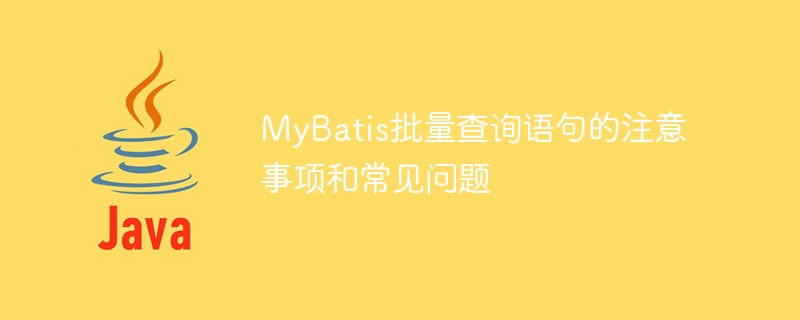

MyBatis batch query statement precautions and common problems
MyBatis is an excellent persistence layer framework , which supports flexible and efficient database operations. Among them, batch query is a common requirement. By querying multiple pieces of data at one time, the overhead of database connection and SQL execution can be reduced, and the performance of the system can be improved.
This article will introduce some precautions and common problems with MyBatis batch query statements, and provide specific code examples. Hope this can provide some help to developers.
When using MyBatis for batch queries, you need to pay attention to the following points:
(1) Set fetchSize appropriately
fetchSize refers to the number of records fetched from the database at one time. By default, MyBatis loads all records in the query result set into memory at once. This may cause memory overflow problems, especially when the number of records queried is very large.
In order to avoid this problem, we can limit the memory usage by setting fetchSize to specify the number of records for each query. For example:
@Select("SELECT * FROM table_name")
@Options(fetchSize = 100)
List<Table> selectAll();In the above code, fetchSize is set to 100, which means that 100 records are queried from the database each time.
(2) Using cursors
Cursor (Cursor) refers to a mechanism used to traverse the result set in database queries. When the number of records queried is large, using a cursor can reduce memory consumption.
In MyBatis, we can use the cursor by setting the ResultSetType to Cursor. For example:
@Select("SELECT * FROM table_name")
@Options(resultSetType = ResultSetType.DEFAULT, fetchSize = 100)
Cursor<Table> selectAllWithCursor();Through the above code, we return the query results in the form of a cursor, thus realizing batch queries.
When using MyBatis for batch queries, there are some common issues that need attention:
(1) Data consistency issues
Since MyBatis is a database access framework based on connection pooling, when using batch queries, multiple queries may use the same database connection. If transaction isolation is not implemented between these queries, data consistency problems such as dirty reads and phantom reads may occur.
In order to solve this problem, we can add the @Transactional annotation to the query method and define it as a transaction method. This ensures that multiple queries are executed in the same transaction, thereby ensuring data consistency.
(2) Large data query problem
When the amount of data in the database is very large, loading all the data at once may cause memory overflow. In order to solve this problem, we can use paging query.
In MyBatis, we can use limit and offset to implement paging query. For example:
@Select("SELECT * FROM table_name LIMIT #{offset}, #{limit}")
List<Table> selectByPage(@Param("offset") int offset, @Param("limit") int limit);Through the above code, we can specify the starting position of the query and the number of records to be queried, thereby realizing paging query.
The following is a complete code example that demonstrates how to use MyBatis for batch query:
@Mapper
public interface TableMapper {
@Select("SELECT * FROM table_name")
@Options(fetchSize = 100)
List<Table> selectAll();
@Select("SELECT * FROM table_name")
@Options(resultSetType = ResultSetType.DEFAULT, fetchSize = 100)
Cursor<Table> selectAllWithCursor();
@Select("SELECT * FROM table_name LIMIT #{offset}, #{limit}")
List<Table> selectByPage(@Param("offset") int offset, @Param("limit") int limit);
}Through the above code example, we You can better understand and use the batch query function of MyBatis.
Conclusion
This article introduces the precautions and common problems of MyBatis batch query statements, and provides specific code examples. By properly setting fetchSize, using cursors, and paging queries, we can optimize system performance and reduce memory consumption.
I hope this article can provide some help to developers who use MyBatis for batch queries, so that they can better respond to actual development needs.
The above is the detailed content of Frequently Asked Questions and Notes: Using MyBatis for Batch Query. For more information, please follow other related articles on the PHP Chinese website!
 mybatis first level cache and second level cache
mybatis first level cache and second level cache
 What is the difference between ibatis and mybatis
What is the difference between ibatis and mybatis
 How to configure database connection in mybatis
How to configure database connection in mybatis
 What is the working principle and process of mybatis
What is the working principle and process of mybatis
 What are the differences between hibernate and mybatis
What are the differences between hibernate and mybatis
 What is the role of kafka consumer group
What is the role of kafka consumer group
 NTSD command usage
NTSD command usage
 What is an .Xauthority file?
What is an .Xauthority file?




